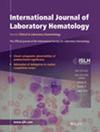Effects of ferroptosis-related gene HSPB1 on acute myeloid leukemia
Abstract
Introduction
The purpose of this study was to investigate the effects and potential mechanisms of ferroptosis-related gene heat shock protein beta-1 (HSPB1) on acute myeloid leukemia (AML).
Methods
The RNA-seq and clinical data of AML samples were obtained from the Genomic Data Commons database, and the FerrDb database was used to screen the marker, drive and suppressor of ferroptosis. Besides, DESeq2 was applied for differential expression analysis on AML samples and screening for differentially expressed genes (DEGs). The screened DEGs were subjected to the intersection analysis with ferroptosis-related genes to identify the ferroptosis-related DEGs. Next, the functional pathways of ferroptosis-related DEGs were further be discussed by Gene Ontology as well as Kyoto Encyclopedia of Genes and Genomes enrichment analysis of DEGs. Additionally, lasso regression analysis was employed to determine the differential genes related to prognosis in patients with AML and the survival analysis was performed. Subsequently, quantitative real-time polymerase chain reaction and western blot assay were applied to detect the mRNA and protein expression levels of HSPB1 in normal/AML bone marrow tissues and human normal (HS-5)/AML (HL-60) bone marrow cells, respectively. Furthermore, HSPB1 was knocked down to assess the expression changes of glutathione peroxidase 4 and acyl-CoA synthetase long-chain family member 4. Ultimately, the viability and oxidative stress levels of HL-60 were analyzed by Cell Counting Kit-8 and biochemical detection.
Results
A total of 4986 DEGs were identified in AML samples, with 3324 up-regulated and 1662 down-regulated. The enrichment analysis illustrated that ferroptosis-related DEGs were significantly enriched in response to metal irons, oxidative stress, and other pathways. After lasso regression analysis, 17 feature genes related to the prognosis of patients with AML were obtained, with HSPB1 exhibiting a significant correlation. The reliability of our models was verified by Cox regression analysis and survival analysis of the hazard model. Furthermore, the outcomes of quantitative real-time polymerase chain reaction and western blot showed that mRNA and protein expression levels of HSPB1 were significantly increased in the AML Group and HL-60 cells. The knockdown of HSPB1 in HL-60 cells reduced the protein level of glutathione peroxidase 4, increased the protein level of acyl-CoA synthetase long-chain family member 4, decreased the cell viability, and aggravated oxidative stress.
Conclusion
Ferroptosis-related gene HSPB1 is highly expressed in patients with AML. In addition, HSPB1 may be involved in the occurrence and development of AML by regulating oxidative stress and ferroptosis-related pathways. This study provides new clues for further understanding of AML molecular mechanisms. Also, HSPB1 is expected to be a potential therapeutic target for AML in the future.

 求助内容:
求助内容: 应助结果提醒方式:
应助结果提醒方式:


